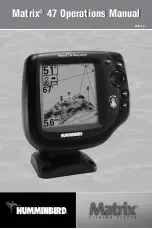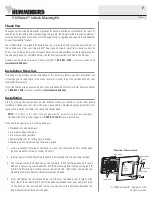
15
To perform a final test of the transom transducer installation:
After transom transducer installation, please perform the final testing and then
finalize the installation (see
Test and Finish the Transducer Installation
).
INSIDE THE HULL TRANSDUCER INSTALLATION
If you choose to mount your transducer inside the hull of your boat, perform the
procedures in this section. In-hull mounting generally produces good results in single
thickness fiberglass-hulled boats. Humminbird® cannot guarantee depth performance
when transmitting and receiving through the hull of the boat, since some signal loss
occurs. The amount of loss depends on hull construction and thickness, as well as the
installation position and process.
This installation requires slow-cure two-part epoxy. Do not use silicone or any other
soft adhesive to install the transducer, as this material reduces the sensitivity of the
unit. Do not use five-minute epoxy, as it has a tendency to cure before all the air
bubbles can be purged, thus reducing signal strength.
NOTE:
In-hull mounting requires an installed and operational control head.
Determine the transducer mounting location:
Decide where to install the transducer on the inside of the hull. Consider the following
to find the best location:
• Observe the outside of the boat hull to find the areas that are mostly free from
turbulent water. Avoid ribs, strakes and other protrusions, as these create
turbulence.
• As a general rule, the faster the boat can travel, the further aft and closer to the
centerline of the hull the transducer has to be located in order to remain in contact
with the water at high speeds.
Trial installation:
You will not be able to adjust the mounting after an inside the hull transducer is
installed. It is best, therefore, to perform a trial installation first that includes running
the boat at various speeds, in order to determine the best mounting area before
permanently mounting the transducer.
1. Plug the transducer into the control head, then power up the control head.
When the control head detects a functioning transducer, it will automatically
enter Normal operating mode.
2. View the sonar signal at its best by holding the transducer over the side,
immersed in the water, so that it is pointing straight down over a known flat
bottom. Use the display to benchmark against the sonar signal that will be
detected once the transducer is placed in the hull.
3. Place the transducer body face down at the identified mounting location inside
the hull, with the end that has the mounting ears pointed towards the bow of
the boat.
Rivets/Strakes
1
Step
2
1
Preferred Mounting Area
2
531374-1_A - 947 Man.qxd 2/15/2005 7:53 PM Page 20
































